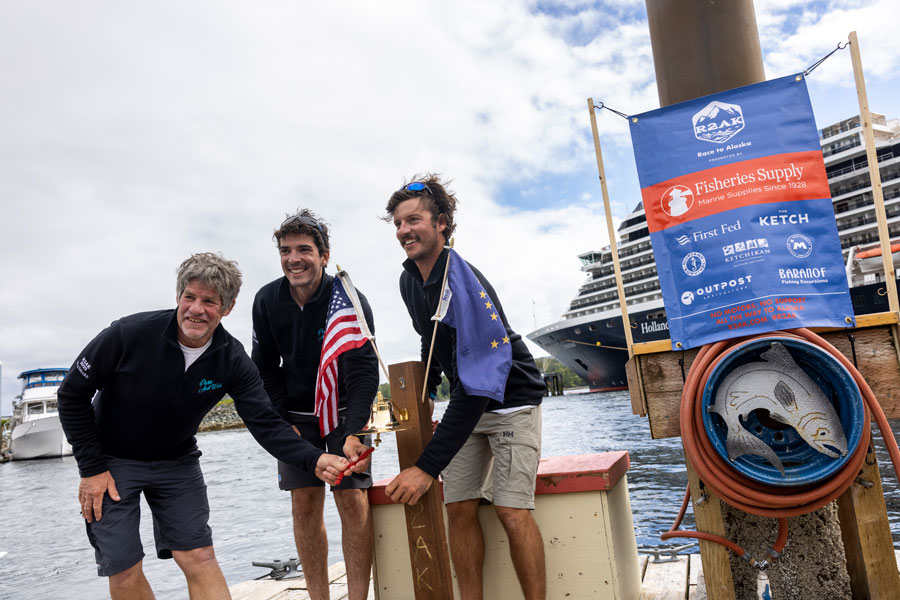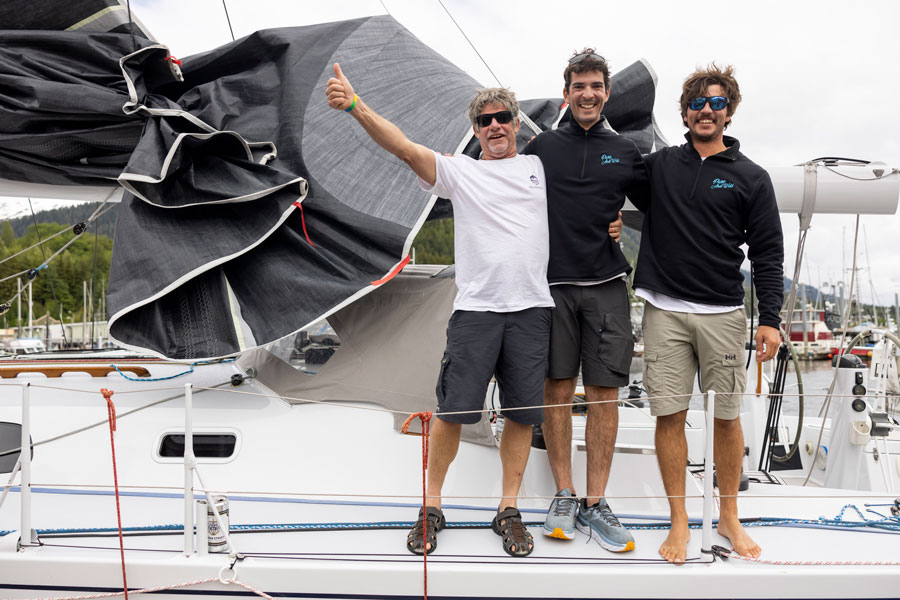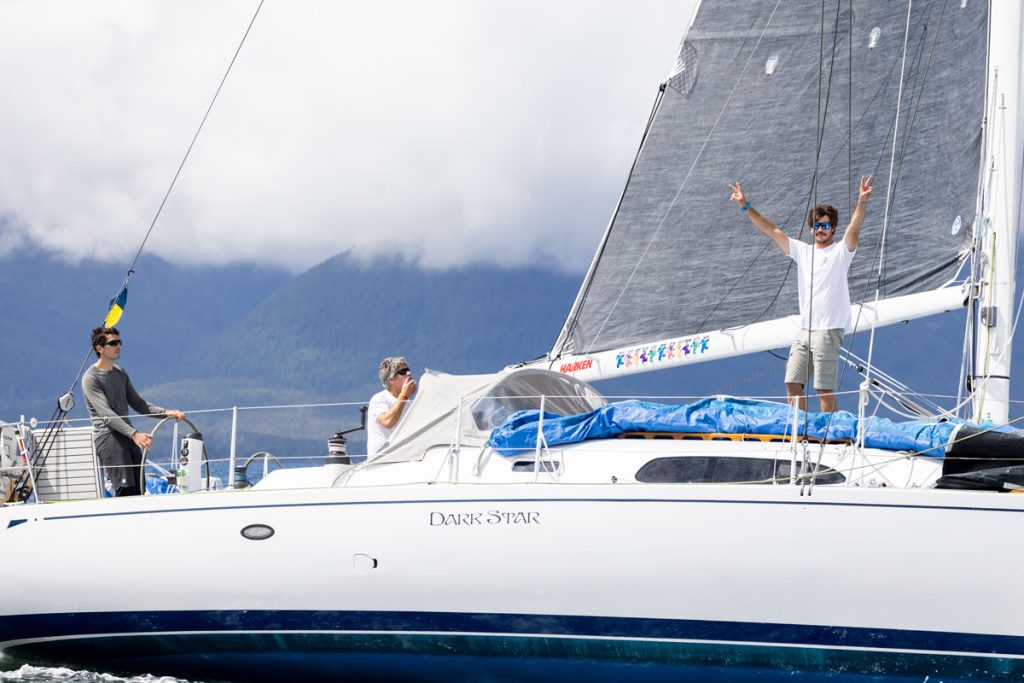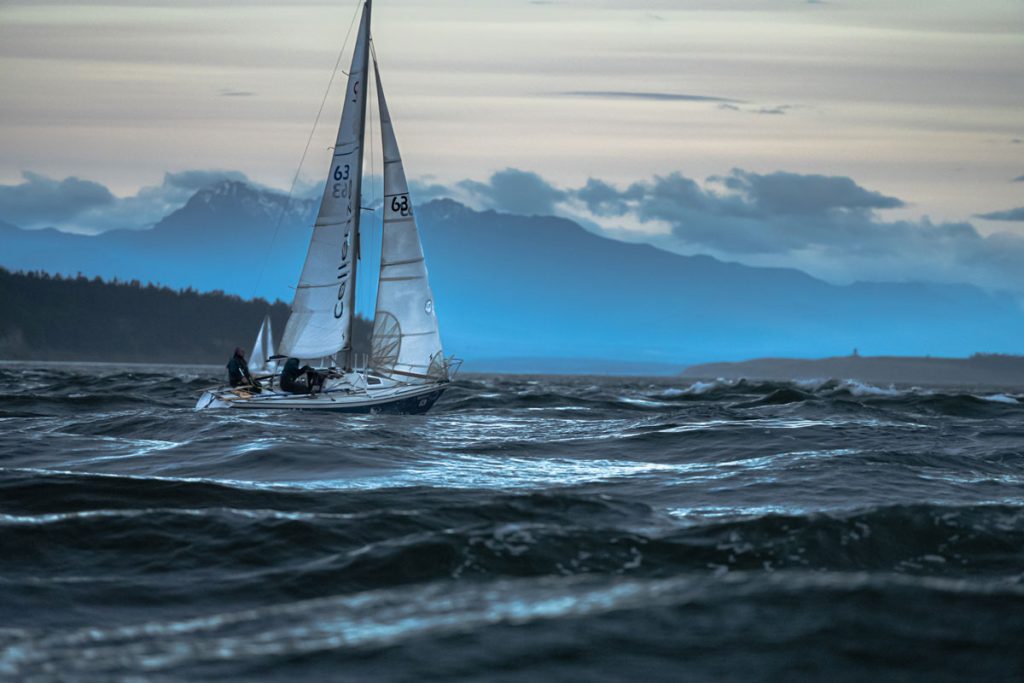Field Report | 24-Hr Fact Sheet
photo: Team Pure and Wild by Thomas Hawthorne
It’s been years since Ketchikan welcomed R2AK’s finishers to its shores, but by the early hour of Team Pure and Wild’s crossing of Dixon Entrance, you could tell that things were happening in welcomed and familiar ways. As their tracker blip went from “When will they get here?” to “We better hurry!” fans clad in R2AK swag migrated from disparate corners of the community to a slow-forming flash mob that converged on the docks of the Alaska Fish House to wait for R2AK’s first finishers.
In truth, the preparations started weeks before. Volunteers made a new stand and polished the bell, the local newspaper had been peppering the headlines with updates, fishing guides volunteered to take the various cameras from R2AK and local TV to catch the team’s final approach, cash and firewood were placed on standby. It had been years, people were ready.
This was true in the five previous R2AKs, but this year’s vibe had a pent up, “Yay, and thank god” energy. There has always been a cheering mass on the dock, and the stalwart fans from Ketchikan were joined by others who had been similarly inspired. Staff of nearby restaurants ignored customers for a few minutes to cheer in the winners. A couple made the trip down from Anchorage, another up from Texas, and at least a few from Port Townsend to be part of the celebration. Class acts to the end, Team Pocket Rockanauts might have exited the race early but made it to Ketchikan to be part of the action, and a passenger on a nearby cruise ship joined the crowd just to see what was happening. She arrived uninformed, but Joy from Salt Lake left as the race’s newest fan and tracker enthusiast. Took pictures with the team and everything. The mood was the good kind of contagious, and if you believe the woowoo that good energy can manifest in the natural world, for at least four hours it didn’t rain. Yes, in Ketchikan.
After a run under sunny skies, Team Pure and Wild was welcomed with cheers and applause—4 days, 4 hours, and 32 minutes after they left Victoria. As they say in these parts: Welcome to done.
They rang the bell and drank the beers, kissed their loved ones, and offered thanks. There were cameras and microphones (so many cameras and microphones), questions and stories, and crowd-wide curiosity about what had happened in the last 750 miles. In the KTN and across the global Tracker Nation, fans chimed in to share in the joy and were eager to learn how they did it.

Finish lines are the natural habitat of platitudes, and the team’s warm collected remarks on a rare rainless day seemed to reinforce a dreamy state of topline perfection. Regardless of when racers finish (or not), Race to Alaska is often defined by a profanity-laden freight train of hardship and grit, of overcoming the sum total of logs, calms, and gales between start and finish. If one were to simply look at Team Pure and Wild’s abstract and believe the first offered version of their elation-fueled stories, it could feel suspiciously picket fenced and perfect. Olympic and otherwise accomplished sailors, on a fast, custom, and proven vessel that finished not just first but more than a timezone ahead of the nearest competitor, all culminating in a downwind, down current, sleigh ride in the sun that ended in $10,000 and their sweeties waiting on the dock. It all seemed too perfect.
On the surface, to habitual rock throwers and the “It’s not fair for the little guys” set, it looked like this episode of the R2AK was less of a Man-vs-Monster, late-night horror show of human struggle against impossible odds, but an after school special where things were ok, then ended up even better.
Where was the suffering, the agony, the exhaustion? Where was the rain-soaked 2 am finish where haggard, limp drysuits stagger off their boat in a pile of walking exhaustion and struggle to muster that last crumb of sleepless adrenaline just to ring the bell before crawling into a wet bed one last time because they were too tired to move? Some people watch NASCAR for the chance of a crash, and as thousands of fans as far away as Australia reveled in TPW’s accomplishment, to those who judge worth by proximity to failure, this all seemed suspiciously easy.
To the delight of race fans, our underwriters, and the US Coast Guard alike, Team Pure and Wild’s race wasn’t a journey to their ragged edge, but a honed demonstration of what’s possible for the incredibly capable.
It wasn’t all teacakes and daisies. Were there hairy moments? Totally, but they were met and dealt with. From pounding into big seas for the length of Vancouver Island, a sketchy full send shimmy out the bowsprit to retrieve a wayward tackline, the log strike in Hecate, to shredding their spinnaker as they took it down on the final night—there were plenty of occasions to rise to. One night it was so rough and uncomfortable that at least one of them got seasick despite his many ocean miles. “I ate a Dramamine then immediately puked.” The difference between these and the same-themed stories from teams who make it to Ketchikan by the skin of their teeth is that these moments of challenge weren’t survived, they were executed.
Were they tired? Sure. Their crew had been sleeping three hours out of every nine since the race began. Three hours to sleep, three at the helm, and remaining three to make food, help out on deck, and other household chores.
By our estimation, as much as their experience manifested in their ability to sail fast and safely (and they 100% did), Team Pure and Wild had two secret weapons: real food and ballast.
It seems subtle, but the ability to have relative comfort has an underrated importance in a race as long as this. You can grit your teeth for a couple days of sleeping in a wet drysuit, but finding relative comfort helps you recharge, keeps up morale, and as we know from watching Team Fashionably Late: happy crews sail faster.
Rather than the standard, boat weight conscious, racer menu of Jetboiled bags of meal-flavored rehydrated calories, Team P&W decided to spend the weight they saved by only packing one shared sleeping bag, with pre-making enough real food to last them the trip. Yes, it was a four item menu that fell somewhere between “fourth grade birthday” and “frat house,” but the pizza, lasagna, chili, and chicken fingers that they ate for breakfast, lunch, and dinner had the calories, sustaining comfort, and practical application to keep them going. “After the third time in the oven, the top layer of the lasagna got pretty burnt, so we’d just peel it off and have at it.”
We can only speculate, but given TPW’s new-found glory our guess is that “Lasagna: it’s not just for breakfast anymore” and “Lasagna: the food with a disposable top” are front runners for the Lasagna Council’s next ad campaign.
Also, did you catch that? The boat has an oven. They could have made cookies.
Secret weapon #2: ballast. Enabled by R2AK’s Wild West rules, the team’s ability to move weight from low side to high side played a huge role in their performance. The Riptide 44 Dark Star, already had built-in water ballast; port and starboard tanks that allow you to fill the windward tank with water to counterbalance the force of the wind and keep the boat flatter and faster. Short course race boats use meat ballast: humans who clamber side to side between tacks, using their girth to do the same thing as the tanks. TPW’s water ballast system works like this: just before you tack, you use gravity to drain the water from the high side to the low side, then tack over. Low side with all the water on it becomes the newly weighted high side, and Bob’s your uncle. But what about right before you tack when the water is downhill and exactly where you don’t want the weight? “It’s a little sketchy,” but the water ballast system allowed them to drive big boat performance with a shorthanded crew.
Adding to the effect, they also restacked their gear. Each time they tacked, one person would drive, one person would winch, and one person would restack and retie hundreds of pounds of sails and gear stowed both on deck and down below. They rotated the task depending on who had energy and who needed to get warm. “It was a lot of work, you got pretty sweaty.” Especially restacking their sails, which were stowed on deck; moving them to the high side meant you had to start in the elements on the wet and pounding low side. How much did all of that weight shifting matter? Their guess is they gained at least a knot, maybe two—a speed increase of 10–20%. “One of the reasons I love this race is that it allows us to sail the boat to its potential rather than to a set of rules.”
The talk around the dinner table ping-ponged from laughter-filled recollections to the technical debrief of what sails they used and when, to a deep reverence for the experience they just shared and the coastline they just experienced. The sound of whales blowing less than half a mile off in the dead calm near Bella Bella, the pitch black transit around Cape Scott whose only light was the glowing phosphorescence of their bow wake and the outline of a fish swimming alongside for a length of time somewhere between amazing and disturbing. “I stared at it for five minutes before I had the nerve to ask Alyosha if he could see it too. I thought I was going crazy.”
More than their experience and the race itself, talk soon turned to wondering about their fellow racers still on the course. All of the damage from logs, how much they learned about paddlewheels from Team Stern Wheelin’, and where was Zen Dog? While they were proud of pioneering the outside route, their excitement was genuine as they learned that their “sistership,” Team Dark Star (the same-named boat of a vastly different design), was pioneering another by deviating from the standard inside route through Seymour to an even inside-er one. In a matter of hours, the winners had gone from competitors to race fans glued to the tracker.
Champions of spirit and of deed, Team Pure and Wild is sailing to raise awareness and funds for SeaShare, a non-profit that works with the fishing industry to get seafood’s high-quality protein into food banks and other food assistance programs. Pretty cool.
Our hats are off to the champions of Team Pure and Wild, and with the winner in, the race is just getting started; 26 teams are still fighting to Ketchikan. Race on!

24-Hr Fact Sheet
- 36 – Minutes Team Pure and Wild missed getting the R2AK World Record for fastest monohull (2019 Team Angry Beaver – Skiff Sailing Foundation – 4d 3h 56m)
- 1 – Number of people who have taken first place in multiple R2AKs (Matt Pistay 2019, 2022)
- 10,000 – Calories Team Don’t Tell Mom planned to eat daily (2 people)
- 18.83 – Least mileage of any team so far in a 24-hour period (Team Dark Star)
- 183.3 – Highest mileage of any team so far in a 24-hour period (Team Pure and Wild)
- 25% – Of full race teams have dropped out
- 6 – Years Liz Harpold has swooped into Ketchikan and fixed all the finish time errors R2AK High Command has botched
- 13:3 – Ratio of times Team Let’s Row Maybe? have talked about their blisters to how many blisters they have
- 20% – Of teams currently racing have passed through the mid-way checkpoint of Bella Bella (4.5 days into the race)
- 20% – Of teams currently racing have not exited the Strait of Georgia yet (4.5 days into the race)
Field Report: Undeterred: The ins and outs of buying and sailing a boat you’ve never seen before
By Jim Meyers, Field Reporter
If the roughly 750 miles of wild currents, swells, unpredictable winds and vast stretches of remote, ocean wilderness (and bears) of the Race to Alaska lead you to believe that the humans who embark on this challenge are seasoned sailors and paddlers of such fickle waters, you’re right. Even the youngest adults on the course have at least tasted such things before, with some spinning tales of great ocean races across the globe before they’ve fully traversed their second decade.
If, on the other hand, you thought that all the folks subjecting themselves to this madness have been over the tiniest details with a fine-toothed comb for years in preparation, you’d be flat wrong. In fact, it’s their experience that enables them to clear seemingly insurmountable hurdles to get here on short notice, with sailing vessels some have never seen before. For some though, the hurdles just keep coming.
Enter Boris Rohou and Nathalie Fouet of France and, more recently, Team Loustic SuperSonic, of the R2AK, of Port Townsend, of…never mind… Keep Reading

